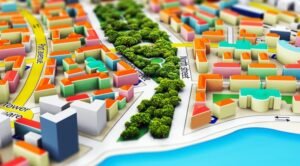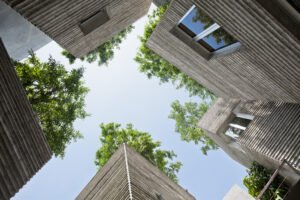For any sustainable city to thrive, the two major components of urban planning, land-use planning, transportation networks, must be implemented and managed. A city will set out to have a land-use pan that preserves a natural setting as possible. A well-designed urban plan has designed bike routes and walking plans near gree spaces, with roads that feature in a natural setting, increasing the aesthetics and viability of transportation alternatives.

The Evolution of Urban Planning:
In a dense urban setting, the pursuit of outdoor thermal comfort is a development goal that included a sustainable plan. The current definitions of urban planning include economic factors along with conservations and environments. Urban planning is conceived like a business plan, where the potential revenue increases in order to attract investors. Mass transit networks are useful in demonstrating revenues in the process. The areas of urban environments are developed closely with access to the transits to determine the business developments and employment opportunities.
One of the major emphasis in sustainable city design is the reduction of urban sprawl. Urban developments also focus on pedestrian and cycle paths, in proportion to roads and cars. Urban planners use green infrastructure and understand its benefits through planning processes. Green infrastructure introduces standalone and strategically networked environmental features that are designed for environmental, social and economic benefits.
The benefits of green infrastructure includes reduced urban heat, low building energy demand and improve storm-water management. The drawbacks can be mitigated through good designs. Some issues like cost management, tree roots, bushfire hazards, and power-like interference can also be mitigated.
Working through the Planning Processes:
Planning systems play an important role in shaping the design of the cities that are used globally, including- plan-making, development management, urban design, and pre-planning consultations. Green infrastructure can be implemented in the planning process and doesn’t require major changes.

Looking for design standards for materials, buildings and space is another important planning process. The green infrastructure delivery improves during planning systems creates supportive design standards and embedded them in plans. Pre-planning consultations also has a role to play and can be used from an early stage to determine the technical and cost issues that green infrastructure poses for developments. Following listed pointers include how we can enhance and make our urban environments sustains:
- Reduction of stress: Traffic, noise, overcrowded public transport, everyday people who live in cities are confronted with stressful situations. To return to the peaceful and quiet, green city planning, it is necessary to consider the roadways, pathways and alternative means of transport like – bikes, scooters, electric cars as they better contribute to the quality of life.
- Reduction in pollution: It is the fact that our planet is suffocating and polluted causing diseases like asthma, chronic coughs, and even cancers. The best way to reduce pollution is to plant more trees and trees can retain up to 5.4 metric tons of CO2 and 20kg of dust a year.
- Increase in real estate value: The buyers are increasingly interested in homes enclosing gardens or parks, escalating the prices. A space under 100 meters from home boosts its values by Rs 10,000.
- Education in Biodiversity: Introducing and educating people and residents about vegetated spaces and ecology to encourage biodiversity will benefit the interaction between plants, animals, and humans.
- Rainwater Management: Drainage has low absorption capacities and adverse factors of concrete covering the ground that prevents rainwater from soaking in. Green city planning using plants requires water effectively and benefits in all aspects.
- Better Health: Green urbanism also improves physical health, mental health, and social healths.
- Helping with social integration: Urban planning also creates jobs and social links by including dedicated green spaces in development schemes.
- To cool cities: Heat waves are increasingly frequent and in cities where the building block air flows, developing systems like green spaces, sustainable urban planning will bring effective outputs.
Green city planning promises a better future to everyone and being aware of the environmental challenges now, it the best mitigation one can adapt. Existing planning processes can accommodate green infrastructure relatively easily. The question remains, why aren’t we seeing more green infrastructure in general? It’s because the new technologies have disrupted the embedded practices.
To know more about Architecture Technology, Stay Tuned.

